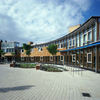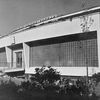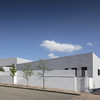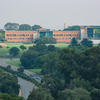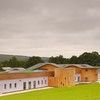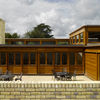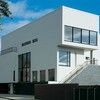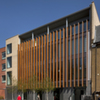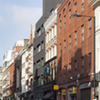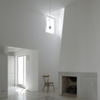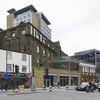Wingene
Subscribe now to instantly view this image
Subscribe to the Architects’ Journal (AJ) for instant access to the AJ Buildings Library, an online database of nearly 2,000 exemplar buildings in photographs, plans, elevations and details.
Already a subscriber? Sign in
Warm natural accents through the use of wood, indirect soft lighting, views of the courtyard and the surrounding green areas from all rooms create a peaceful atmosphere
Kristien Daem Download Original
A spacious facility for the elderly in Flanders.
The Wingene care home is carved out by courts and consists of 145 rooms with apartments for assisted living at ground level, together with a daycare centre and local services centre linking to the wider community.
The distinctive gabling of the façades is a conscious reference to typical Belgian terrace profiles of repeated individual gables. The regular grid of large square windows is subtly variegated, composed of differing sizes: the larger indicating communal rooms; the smaller, private rooms. The latter have to one side an indented panel of ceramic tiles, each unique in colour and pattern. These are the work of artist Benoît van Innis, who, taking Sergison Bates’ concept of coloured ‘curtains’ marking the identity for each room and resident, pushed it to an extreme of individualisation: painting each of the 45,000 tiles by hand.
The slim Flemish bricks of the façades are laid in seemingly random ‘wild bond’, mitigating any pattern from being picked out by eye, with slightly thicker alternating projecting courses at lower level, giving gentle rustication and weight to the base.
To the south, the main entrance sits at the back of a deeply cut-back court, approached under a chunky steel canopy, which bifurcates halfway down to serve the daycare centre entrance as well.
Rooms are arranged in clusters around communal day rooms, giving every floor of each wing a heart for its residents. Each pair of rooms is set back in a shallow alcove off the corridors, framed by shared linking thresholds. Each room is simply detailed, with timber-framed windows, desks and chairs.
The technical sustainability strategy for the building is based on a ‘fabric-first’ approach that significantly reduces heat loss and minimises energy requirements. The building is designed with a very low air leakage rate and low thermal bridging factor to ensure an efficient background building.
A heat pump operating through geothermal pile foundations provides a renewable
ource for heating and cooling. In the summer, chilled water is pumped through tubes cast into the concrete slab using an innovative ‘active concrete’ system that passively cools communal spaces in a sustainable way. In the winter the same pump feeds warmed water through the underfloor heating system.
Roof-mounted photovoltaic cells provide a high proportion of the centre’s electricity requirements and mechanical, external sunshades prevent over-heating. Rainwater is harvested from all roofs, stored and re-used in the toilet flushing system.
Data
- Begun: Jun 2014
- Completed: Apr 2016
- Floor area: 11,160m2
- Sector: Healthcare
- Total cost: £15.4M
- Address: Sint-Amandsstraat 2, Wingene, 8750, Belgium
Professional Team 
- Architect: Sergison Bates Architects
- Project architect: Kirsten Gabriëls Webb
- Client: Amphora
- Project support: Bureau Bouwtechniek
- Structural engineer: Norbert Provoost Ingenieursbureau
- M&E consultant: Ingenium Nv
- Acoustic consultant: Daidalos Peutz
- QS and CDM co-ordinator: Bureau Bouwtechniek
- Main contractor: Strabag Belgium, Ghent
- Landscape consultant: Wirtz International
- Project Artist: Benoît van Innis
- CAD software used: Vectorworks

















